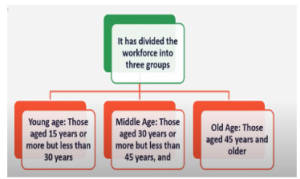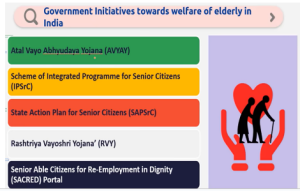Context:
An analysis of India’s workforce, sourced from Centre for Monitoring Indian Economy (CMIE) Economic Outlook data reveals that despite having the largest youthful population, the workforce is undergoing a significant aging process.
Young Indians, Aging Workforce:
- Increase in Youth Population: The segment of the population categorized as youth increased in size from 35.49 crore in 2016-17 to 38.13 crore in 2022-23.
- Decline in Young Workforce: In 2016-17, there were 10.34 crore people under the age of 30 years in the workforce. By the end of 2022-23, this number had fallen by over 3 crores to just 7.1 crore.
Highlights from the CMIE Survey:
- Decrease in Young Age Workforce: The share of India’s youth has fallen from 25% in 2016-17 to just 17% at the end of the last financial year in March.
- Decrease in Middle Age Population: The share of those in the middle age group has fallen from 38% to 33% over the same period.
- Increase in Ageing Population: The oldest age category has grown its share from 37% to 49% with the portion of those aged 45 and above rising from around one-third to nearly half.
- The increase of 60+ population in a 50-year time span, i.e. from 2011 to 2061, is expected to be more than 320 million.
Composition of the Workforce by Age Group in India:

- Decreasing Youth Employment rates: The youth in India witnessed a substantial 31% decrease in employment over the past seven years.
- 15 to 30 Age Range: Seven years ago, 29 out of every 100 individuals within the 15 to 30 age range used to be employed. Presently, the figure has dwindled to 19 out of every 100.
- 25 to 29 Age Range: The age range of 25 to 29 years displays an upward trend in employment rate over the last seven years.
Challenges with Aging Workforce:
- Lack of Elderly Care Structure: India currently lacks a comprehensive infrastructure for elderly care and a viable social support system for senior citizens.
- Huge burden on state exchequer: A significant portion of state governments’ revenues is consumed by pension expenses. Only one-third of the elderly in India receive some sort of pension.
- In Gujarat, the pension bill was 159 percent of the expenditure on salary and wages.
- Quick Pace of Ageing: The older population is projected to take only 20 years in India to double.
- It took 110 years and 80 years to double its sharein France and Sweden respectively.
- Poor Social Security Coverage: 90% of the workforce in India is in the informal sector, which has poor social protection for older persons, compounded by their relatively low savings.
- Increased Poverty among the Aged: A 2012 study by the United Nations Population Fund shows that poverty rates are higher among older persons, with a large proportion of them being economically fully dependent (52%) and partially dependent (18%) on others for livelihood.
- 9.3 million individuals aged 61 and older availed work benefits under the Mahatma Gandhi National Rural Employment Guarantee Act (MGNREGA) scheme in 2019-20.
 Poor Access to Health Services: India’s expenditure on health as a proportion of GDP was only 0.95%, compared to 3% in China and 8.5% in the US. It’s lower than the average for low-and-middle income countries (2.8%) and Sub-Saharan Africa (1.9%).
Poor Access to Health Services: India’s expenditure on health as a proportion of GDP was only 0.95%, compared to 3% in China and 8.5% in the US. It’s lower than the average for low-and-middle income countries (2.8%) and Sub-Saharan Africa (1.9%). -
- The number of doctors per 10,000 people was only 7.8 in India compared to 17.9 in China and 81.9 in Cuba.
- Tokenistic Government Schemes: Numerous programs targeting the elderly exist, but they tend to be symbolic and lack the necessary depth and financial backing.
Way Forward:
- Differentiated Approach for Planning: The percentage of the overall population occupied by older individuals varies across different states. It’s lower in the north-central states and higher in the southern states.
- This emphasizes the necessity for tailoring distinct strategies for planning based on the specific circumstances of each state.
- Increased Spending on Human Development: Investment will be particularly helpful for states such as Bihar, Uttar Pradesh, Rajasthan, Madhya Pradesh and Chhattisgarh, which have a growing young population but lag in human development.
- Increasing the Retirement Age: Progressively increase the retirement age, helping governments in keeping the pension system solvent.
- ASHA for Elderly: A network of caregivers and facilities dedicated to elder care needs to be established. This would involve engaging unemployed working- age adults in providing services to the elderly
- Reaping the Benefits of the Silver Economy: Companies need to develop a more holistic approach to address the needs of older workers and ensure that they are able to continue working and contributing to the economy.
- Promoting Inclusivity: Issues such as ageism and discrimination need to be addressed and greater inclusion and diversity in the workplace needs to be promoted.
- Re-employment: India needs to harvest the financial potentials the elderly hold and empower them at the same time, through re-employment or employment in alternative roles.
- For example, Japan introduced a voluntary re-employment system for retirees who can join back the workforce as part-time employees with different work hours and wages.
News Source: The Indian Express
![]() 24 Aug 2023
24 Aug 2023

 Poor Access to Health Services: India’s expenditure on health as a proportion of GDP was only 0.95%, compared to 3% in China and 8.5% in the US. It’s lower than the average for low-and-middle income countries (2.8%) and Sub-Saharan Africa (1.9%).
Poor Access to Health Services: India’s expenditure on health as a proportion of GDP was only 0.95%, compared to 3% in China and 8.5% in the US. It’s lower than the average for low-and-middle income countries (2.8%) and Sub-Saharan Africa (1.9%). 